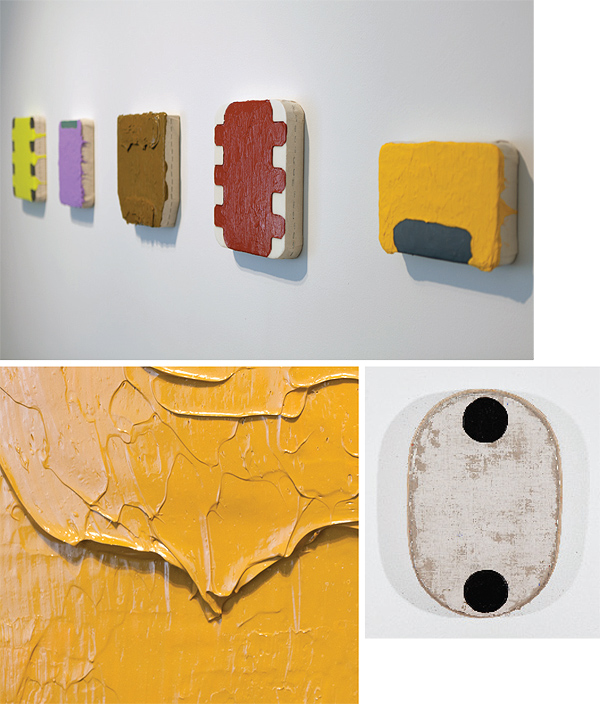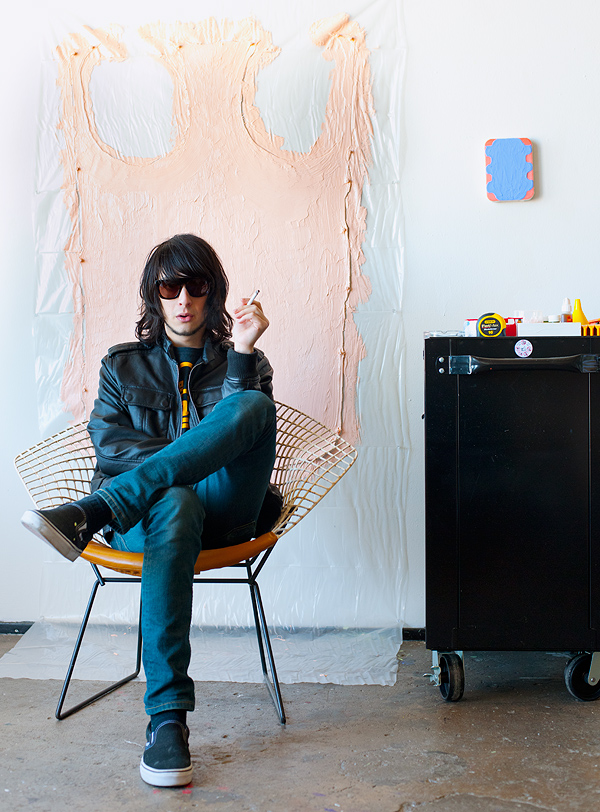“He kind of tagged on me a couple of times at openings. Like, ‘Hey, I’m Bret Slater. Remember we met? And I love your work, and blah, blah, blah,’ ” Jones says. “And I just thought, ‘Oh, well, that’s nice.’ But sometimes it’s, like, too much, you know? I didn’t know who he was or anything.”
Slater found his way into Jones’ life at a curious time. After three weeks in a coma, Jones spent an additional three months at Parkland relearning how to walk and write. When he finally returned to his studio, he could paint, but his energy wasn’t what it used to be. Jones had never worked with an artist assistant before. He couldn’t afford one, and he was protective of his artistic process. But now here was this eager young graduate student going around town telling everyone that Jones was his favorite painter. Jones inquired with a friend who taught at SMU about offering Slater an intern assistantship. Then he took the younger painter out to breakfast at La Duni.
“He was so hyper, and he’s bouncing around. You know, typical Bret, just so full of energy,” Jones says. “But very respectful and very generous and very sincere. And the sincerity came across. I didn’t feel like he was just some kid jacking around. So we just connected, and I said, well, let’s give it a try.”
Before Bret Slater saw his first Otis Jones paintings, he wasn’t making the kind of oddly shaped, candy-colored delicacies that collectors clamor for these days. Slater was painting directly on cardboard, old seat cushions, tape, and other found materials. He was looking at artists like Jim Lee, and when he got to SMU, this process continued.
“It was my reaction to different critiques from different professors,” Slater says. “I also didn’t know what my paintings were about.”
Since he began working for Jones, though, Slater’s approach to and attitude about his work have changed dramatically.
“I started to go over to Otis’ studio,” he says. “I’d be there eight to 10 hours a day. We weren’t working the whole time. Really, we were talking, dialoguing.”

The most significant revelation Slater had while working with Jones was that he didn’t need the found materials to make his work valid. “It is just more about painting being a spirituality,” Slater says. “It is about creating the most personal, one-to-one space that is possible, to have this experience with an object. At the time I still felt that I needed something ‘found.’ Otis helped me realize that at the end of the day, it is arbitrary, especially when we are long dead and gone.”
Slater has done more than absorb Jones’ attitude about the process of painting. Elements of Jones’ pieces have begun to show up in Slater’s.
Jones says, “I’ve had a couple people go, ‘You’ve got circles in your paintings. He’s working for you, and it looks like he’s kind of picking up some things from you.’ And I say, ‘Well, what would you expect?’ ”
Jones insists that Slater is doing exactly what every young painter should do, absorbing the good ideas that surround him and incorporating them into his work. Still, there are times when the line between incorporation and appropriation blurs. When Slater became Jones’ assistant, the older artist just had him stretching canvases. Now he trusts Slater to work directly with the surfaces of his paintings, sanding them.
“He called me one night and said he was at Home Depot, and he wanted to know where to find good sandpaper,” Jones says. “And I said, ‘You just bought an orbital sander like I use, didn’t you?’ He laughed and said yes. I teasingly said, ‘You want to be like me so bad.’ ”
Jones hates the word “mentor,” and what has developed between him and the young artist is more complex than that. “I love Bret,” he says. “I love Bret’s work, and I love Bret. I love him like a son or a brother or an equal. It is not mere mentor-mentoree. He has mentored me as much, just being around that kind of energy and intensity. It’s been refreshing for me.”
Jones also acts as Slater’s chief critic. “I don’t drink the Kool-Aid,” he says when asked about all the affection that has been heaped upon his young friend. Jones then cracks a joke about how dealers reach into their travel bags to pull out another Slater painting for giddy collectors. “Oh, and it’s wonderful!” Jones says sarcastically. “You just reach in the bag and pull out gem after gem. I tease him about being over there making cupcakes, and it kind of pisses him off.”
Jones believes Slater has real talent, that he could sustain a meaningful practice over a lifetime. But Jones worries about how all the attention might affect Slater. “I’m protective of Bret,” Jones says. “I don’t want Bret to get to where he takes himself too seriously. I mean, he would kill me for saying this, but the work is a little over-hyped locally. I think it has to do with Bret’s personality. I think it has to do with he’s young, he’s brash, and he’s hip. You know?”
To put it another way, Slater projects the image of a rock star, and there are too many stories in rock and roll of promising young talent flaming out.
“That’s a danger for a young artist, for any of us,” Jones says. “Because if you start believing the shit that they’re writing, all of a sudden you think you’re just the greatest, and it will never end. And then, when things kind of slow down, it can screw people up.”
OTIS JONES HAS BEEN A RESPECTED FIXTURE in the North Texas art scene for more than 30 years, but no year in his career was quite like 1982. That year his paintings were included in a group exhibition at Rosa Esman Gallery in New York. The gallerist found Jones’ work via Marcia Tucker, the founding director of New York’s New Museum, who had chosen Jones’ pieces as a juror of the New Orleans Triennial in 1980. It wasn’t so much the group show that was the big deal; it was the review that followed, written by New York Times critic John Russell.
“It was only three or four lines maybe,” Jones says. “But to my eyes, it was the most remarkable thing: ‘A young Texan named Otis Jones …’ ”
In those days, it was difficult to find the New York Times in Dallas, and the paper that was sold in Texas didn’t carry the reviews of New York galleries. But the day the review appeared in the paper, Jones’ friends from New York began calling.
“And they were going, ‘Oh, man. You’ve got it made,’ ” he says.
Jones’ friends weren’t the only people calling. Pretty soon Jones was being courted by a handful of New York galleries that were interested in representing him. They wanted to see more of it, and so he asked a friend if he could borrow her Lower East Side studio and use it as a temporary showroom.
“It was a walk-up on Walker Street, south of Canal,” he says. “And it didn’t have an intercom or a buzz-in. So they had to call you to tell you they were down there. And you had to look out the window and see the black limo.”
The dealers liked Jones’ work, but there were concerns. The big one was shipping. Jones lived in Dallas, and getting the work to New York on a regular basis would be expensive. He and his wife considered moving to the city, but with nothing definite in place, they waited to see if any galleries bit. None did.
“You had all the ingredients there to make a cake,” Jones says. “But it just didn’t make a cake.”
Jones sank into depression and stopped painting altogether. He had become obsessed with making it, and when his chance came and went, he was lost. Then his wife got pregnant. “I thought I had to become an upstanding citizen, to make money,” he says. “I was very worried. I was not pro-parenthood, particularly. My wife wanted it, and I thought she deserved it. So I said, ‘Okay, we’ll do it.’ ”
He considered enrolling in law school at SMU, but just a few weeks before their daughter Zoe was born, Jones had another crisis. “I’d gotten all my priorities screwed up working on success,” he says. “Working in the studio became about that and not about fun. I became very disillusioned. I thought, ‘I don’t want to be a fucking lawyer.’ I decided that the best thing I could do for my daughter was to show her who I was. And in order to do that, I had to get up off my ass, pull myself out of the depression, and try to find some joy in making work and being an artist.”
Jones never again found the kind of attention he enjoyed during that brief window in 1982. Instead, he soldiered on. His painting style hasn’t changed much, but his paintings bear the evidence of his dedication to the work, a deepening of sensitivity and sophistication. He sells work through galleries in Dallas, Fort Worth, and Santa Fe, some years barely scraping together enough to make a living.
“In some ways, the fact that I’m still doing this at this age means some sort of success, just in terms of longevity,” he says. “Not in terms of being well-known and well-thought-of or any of those things. But it sometimes amazes me that I’ve been able to do what it is I want to do for so long.”
As with his flirtation with fame in the 1980s, Jones’ medical crisis nearly ended his career. Without the help of his young studio assistant, he couldn’t conjure the mental and physical energy required to produce artwork.
“Being around Bret, I’ve gotten in touch with some of my youth,” he says. “He’s made me challenge myself and look at my own work and ask myself, ‘What do I want to do?’ Just focus a little harder. And it’s funny because it’s all backwards. I’m at a time where I hardly have any energy.”
Jones won’t live long if he doesn’t get a new lung. His name sits near the top of a list for transplants. He can’t leave Dallas. His phone could ring at any moment, and when it does, Jones will rush out the door to the hospital for the surgery that will extend his life—though there is also always the possibility that the surgery could end it.
While he waits for that call, his energetic young friend scurries about, sanding canvases, emptying the trash, doing his part to keep things going.
Right now the biggest decision in Bret Slater’s career is managing his price point. Because he is such a young artist, his paintings have been relatively inexpensive, which has helped fuel demand. But now there is pressure to raise prices. Robertello, the Chicago gallerist, says he has been impressed with the young artist’s savvy throughout the process.
“Bret is really good at managing his own career,” Robertello says. “He keeps really good communications with all three galleries. We meet to pace his price structure, and Bret leads all of that. I’ve never met anyone who is more ready for it. He is very comfortable being at the center of attention.”
He might venture into larger-format work, and there has been talk of moving back to New York. But for now, Dallas has suited Slater. He’s singing for a band called Drain You. He keeps his day job at the Dallas Museum of Art, working just down the hall from where museum administrators met to formally acquire his painting in October. Another acquisition is expected soon from the Indianapolis Museum of Art.
But for Slater, making art is no longer just about getting acquired by a big-name museum, scoring a significant commission, or getting profiled by an art magazine.
“I always said I wanted to be a rock star,” Slater says, taking a drag from a cigarette and reaching for an ashtray, revealing his newest tattoo, a cartoonish reproduction of an Otis Jones painting on his forearm. “Something about my nature, maybe that has been the goal subconsciously. I think of it as six years of contemplating and brooding about how I can make it happen. But now it is not just how can I make my name big, but how can I do something of real substance?”





